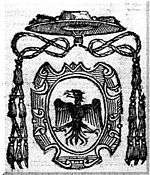Giovanni Battista Cicala
Giovanni Battista Cicala (1510–1570) was an Italian Roman Catholic bishop and cardinal.

Biography
Giovanni Battista Cicala was born in Genoa on June 6, 1510, the son of Edoardo Cicala.[1] His family was related to the Cybo and Doria families.[1] He studied under his relative Odoardo Cicala, who later became Bishop of Sagona.[1]
Cicala moved to Rome, where he was named Referendary of the Apostolic Signatura.[1] On September 2, 1535, he was appointed an abbreviator of apostolic letters.[1] From March 8, 1540 until 1551, he was an auditor of the Apostolic Camera.[1]
On December 5, 1543, he was named administrator of the see of Albenga, while retaining the office of auditor.[1] He was consecrated as a bishop on December 21, 1543 in the Sistine Chapel.[1] On January 13, 1547, he arrived at the Council of Trent.[1]
Pope Julius III made him a cardinal priest in the consistory of November 20, 1551.[1] He received the red hat and the titular church of San Clemente on December 4, 1551.[1] On March 13, 1553, he was named papal legate in Campagna.[1] He resigned the administration of Albenga on March 30, 1554, in favor of his nephew Carlo Cicala.[1] He was administrator of the see of Mariana from March 30, 1554 until September 13, 1560, when he resigned in favor of his nephew Nicola Cicala.[1]
He was a participant in the papal conclave of April 1555 that elected Pope Marcellus II; the papal conclave of May 1555 that elected Pope Paul IV; and the papal conclave of 1559 that elected Pope Pius IV.[1]
With Cardinals Giovanni Michele Saraceni and Gianbernardino Scotti, he was charged with resolving a dispute between the Canons Regular of the Lateran and the Benedictines of Monte Cassino, resolving the issue in favor of the former.[1] He was administrator of the see of Sagona from 1565 to 1567.[1] He opted for the titular church of Sant'Agata dei Goti on November 7, 1565.[1]
He participated in the papal conclave of 1565-66 that elected Pope Pius V.[1]
In 1567, he replaced Cardinal Michele Bonelli as the man in charge of examining the cause for the canonization of Diego di San Nicola.[1] On April 30, 1568, he opted for the order of cardinal bishops, receiving the suburbicarian see of Sabina.[1]
He died in Rome on April 8, 1570.[1] He was buried in Santa Maria del Popolo.[1]
References
| Wikimedia Commons has media related to Giovanni Battista Cicala. |